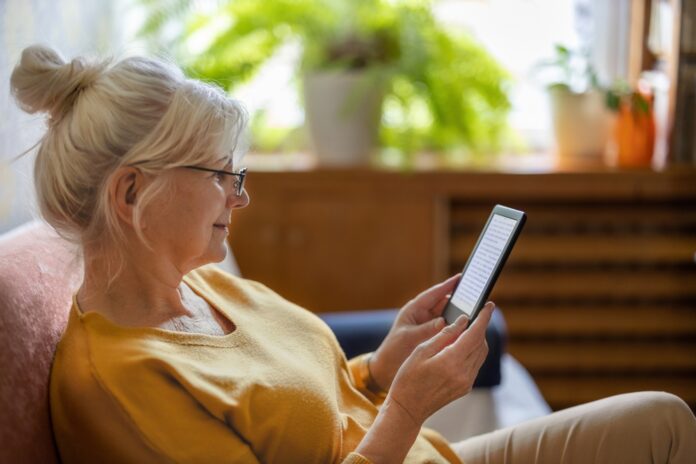For many seniors, the joy of diving into a good book is unparalleled. However, traditional paper books can sometimes present challenges—small print, their physical weight, and the strain of holding bulky volumes in position. Fortunately, e-readers offer a modern solution, combining convenience with accessibility features tailored to the needs of older adults.
Why E-Readers are Ideal for Seniors
E-readers have revolutionized the way we consume literature. They are lightweight, portable libraries that can store thousands of books in a single device. For seniors, this means no longer needing to carry heavy books or strain their eyes with tiny print. Consider the following features common to e-readers:
- Adjustable Font Sizes: One of the most significant advantages is the ability to adjust font sizes and styles, making reading more comfortable for those with visual impairments.
- Lightweight and Portable: E-readers are designed to be lightweight, reducing the physical strain of holding a book for extended periods.
- Backlit Screens: Many devices feature adjustable backlighting, allowing for reading in various lighting conditions without straining the eyes.
- Long Battery Life: Most e-readers boast impressive battery life, often lasting weeks on a single charge.
- Access to a Vast Library: With Wi-Fi connectivity, seniors can easily access thousands of books without leaving the comfort of their home.
Top E-Readers Recommended for Seniors
Choosing the right e-reader involves considering factors like screen size, ease of use, and various add-ons that potentially enhance the reading experience.
1. Amazon Kindle Series
The Kindle series dominates the e-reader market, known for their user-friendly interfaces and affordability.
- Kindle (Basic Model): Ideal for those new to e-readers, it offers a straightforward experience with all the essential features.
- Kindle Paperwhite: With a high-resolution display and adjustable warm light, it’s perfect for reading during the day or night. It’s also waterproof, adding durability.
- Kindle Oasis: Designed for premium comfort, it features an ergonomic design with page-turn buttons and auto-adjusting light sensors.
Pros:
- Easy access to Amazon’s extensive e-book library.
- Simple navigation suitable for non-tech-savvy users.
- Syncs seamlessly across Amazon devices.
Cons:
- Limited to Amazon’s ecosystem.
- Some models can be pricey.
2. Kobo Series
Kobo e-readers are excellent alternatives for those who prefer openness and compatibility with various formats.
- Kobo Clara 2E: Compact and eco-friendly, it’s made from recycled materials and offers comfortable light features.
- Kobo Libra 2: Combines a larger screen with an ergonomic design, including page-turn buttons for ease of use.
- Kobo Sage: Offers a premium experience with a larger display and note-taking capabilities using a stylus.
Pros:
- Supports a wide range of file formats.
- Easily borrow e-books from local libraries.
- Customizable reading settings.
Cons:
- Kobo’s e-book store is smaller than Amazon’s.
- Some models are on the expensive side.
3. Barnes & Noble NOOK Series
The NOOK is Barnes & Noble’s addition to the digital reading market, integrating their vast bookstore with accessible e-reader hardware.
- NOOK GlowLight 4: Offers a sharp display with adjustable brightness and warmth.
- NOOK GlowLight 4 Plus: Features a larger screen and waterproof design.
Pros:
- Access to Barnes & Noble’s extensive collection.
- User-friendly for those familiar with traditional bookstores.
Cons:
- It’s less popular, which might mean fewer accessories or community support.
- Its interface may not be as intuitive as other brands.
4. Apple iPad
While not a dedicated e-reader, the iPad offers versatility beyond reading.
Pros:
- Large, high-resolution display.
- Supports multiple e-reading apps, including Kindle and NOOK.
- Additional functionalities like web browsing, video calls, and apps.
Cons:
- Heavier and bulkier than dedicated e-readers.
- Shorter battery life for reading compared to e-ink devices.
- More expensive option.
5. reMarkable Tablet
Designed for those who love to annotate and take handwritten notes.
Pros:
- E-ink display that’s gentle on the eyes.
- Excellent for note-taking and sketching.
Cons:
- More expensive than standard e-readers.
- Limited functionality focused mainly on reading and writing.
Tips for Choosing the Right E-Reader
Selecting the perfect e-reader depends on individual preferences and needs.
- Screen Size and Quality: Larger screens reduce the need for frequent page turns and can display larger text.
- Ease of Use: Look for devices with intuitive interfaces. For those not comfortable with technology, simple navigation is key.
- Weight and Ergonomics: A lightweight device with an ergonomic design reduces hand strain.
- Battery Life: Longer battery life means less frequent charging, which is convenient.
- Library Access: If borrowing books from a library is desirable, ensure the e-reader supports this feature.
- Adjustable Lighting: Backlit screens with adjustable warmth help reduce eye strain during extended reading sessions.
Making the Most of Your E-Reader
Once you’ve chosen an e-reader, there are ways to enhance the reading experience.
- Join Online Book Clubs: Many devices offer access to communities and reading groups where you can discuss books with others.
- Access Free E-Books: Explore platforms like Project Gutenberg and Open Library for a vast selection of free literature.
- Customize Your Reading Settings: Adjust font types, sizes, and screen brightness to suit your needs.
- Explore Audiobooks: Some e-readers support audiobooks, allowing you to listen to stories, which can be a delightful alternative to reading.
Conclusion
E-readers open up a world of literature without the limitations posed by traditional books. For seniors who cherish the comfort of a good book, these devices offer flexibility, comfort, and accessibility. Whether it’s the straightforward Kindle, the versatile Kobo, or the multifunctional iPad, there’s an e-reader out there to enhance every older adult’s reading journey. Embrace the digital age and rediscover the joy of reading with an e-reader tailored to your needs.


